CHEVROLET CAMARO 1982 Repair Guide
Manufacturer: CHEVROLET, Model Year: 1982, Model line: CAMARO, Model: CHEVROLET CAMARO 1982Pages: 875, PDF Size: 88.64 MB
Page 481 of 875
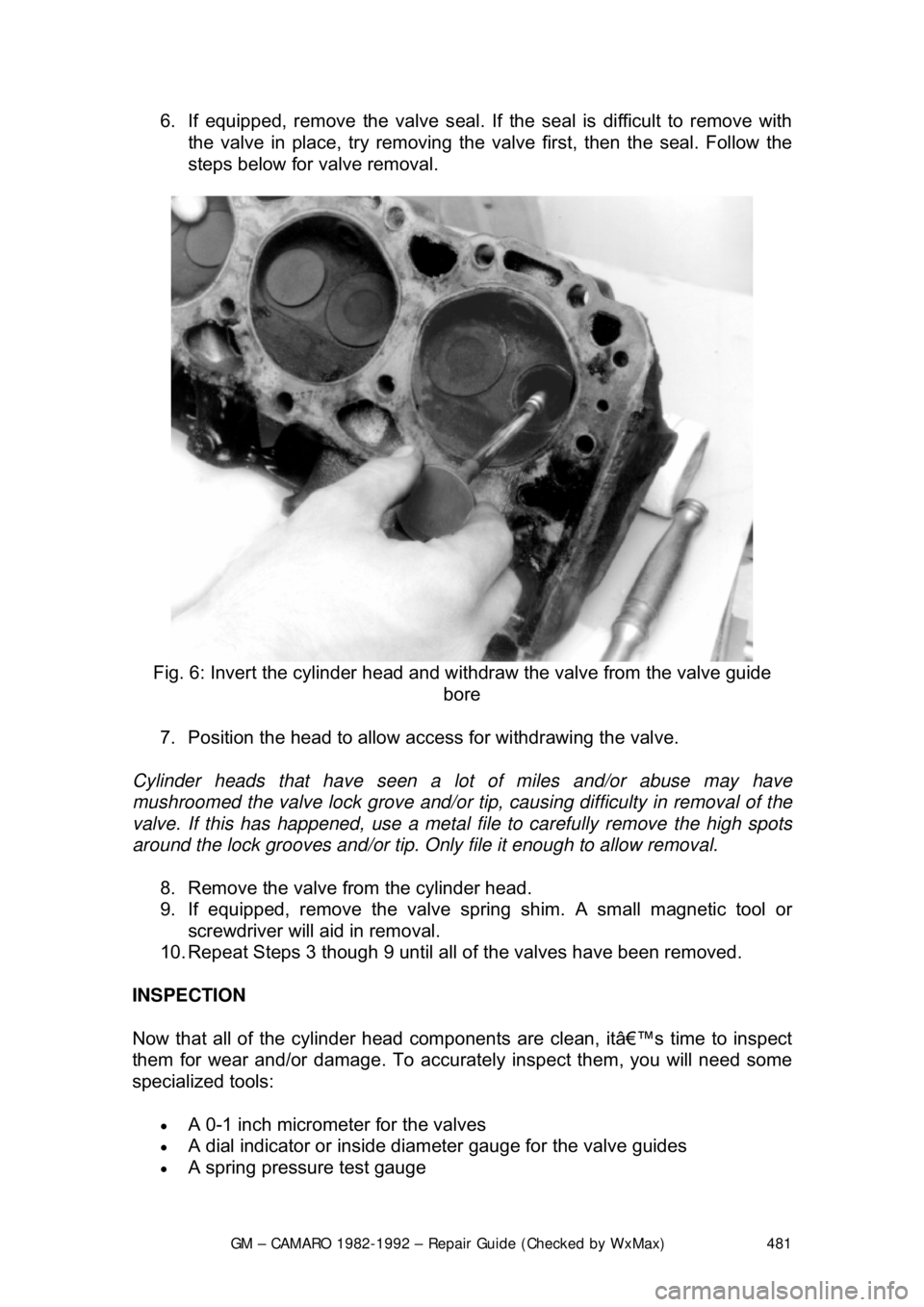
GM – CAMARO 1982-1992 – Repair Guide (Checked by WxMax) 481
6. If equipped, remove the valve seal. If t
he seal is difficult to remove with
the valve in place, try removing the valve first, then the seal. Follow the
steps below for valve removal.
Fig. 6: Invert the cylinder head and wit hdraw the valve from the valve guide
bore
7. Position the head to allow acce ss for withdrawing the valve.
Cylinder heads that hav e seen a lot of miles and/or abuse may have
mushroomed the valve lock grove and/or tip, causing difficulty in removal of the
valve. If this has happened, use a metal f ile to carefully remove the high spots
around the lock grooves and/or tip. On ly file it enough to allow removal.
8. Remove the valve from the cylinder head.
9. If equipped, remove the valve spri ng shim. A small magnetic tool or
screwdriver will aid in removal.
10. Repeat Steps 3 though 9 until all of the valves have been removed.
INSPECTION
Now that all of the cyli nder head components are clean, it’s time to inspect
them for wear and/or damage. To accura tely inspect them, you will need some
specialized tools:
• A 0-1 inch micrometer for the valves
• A dial indicator or inside diam eter gauge for the valve guides
• A spring pressure test gauge
Page 482 of 875
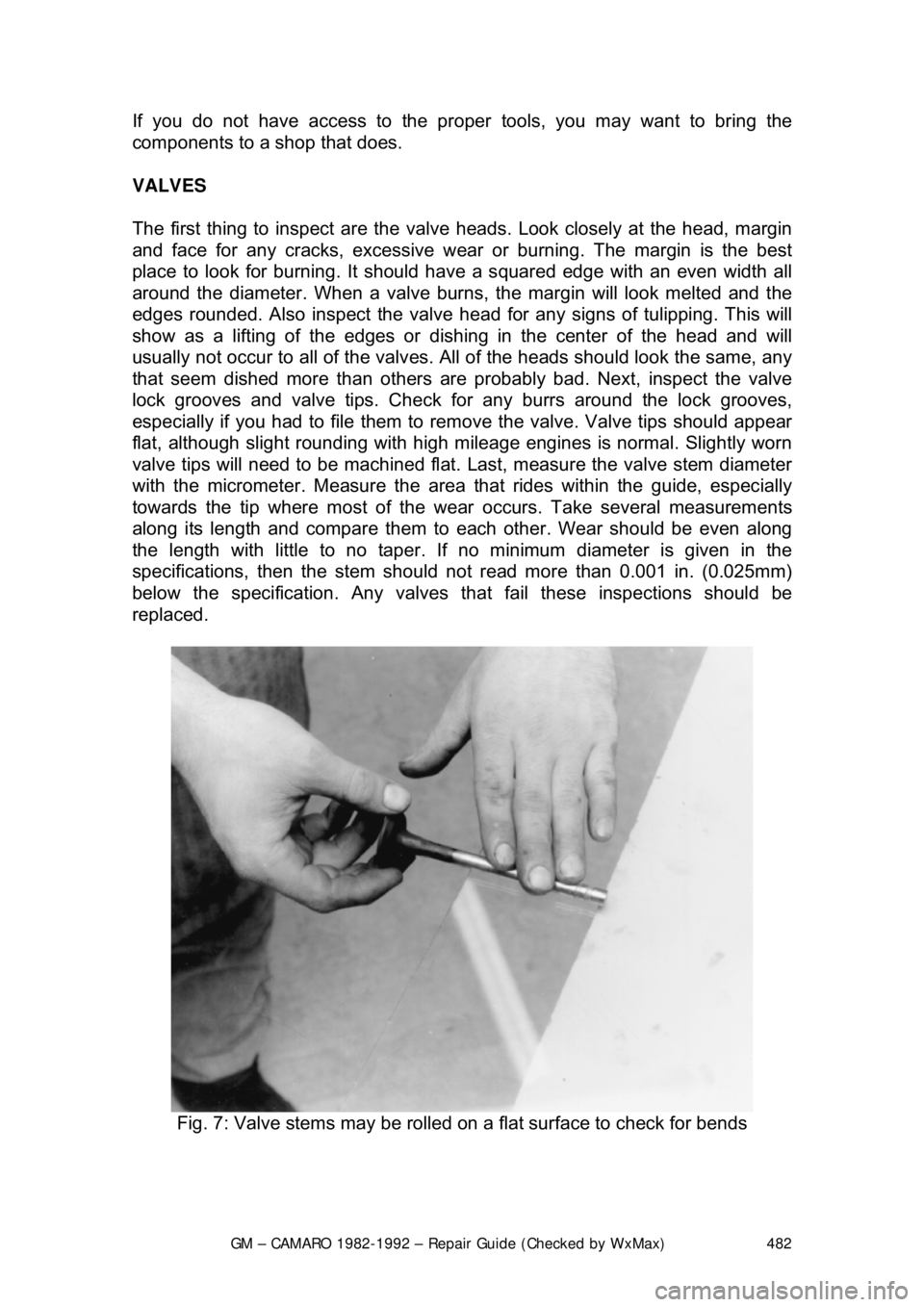
GM – CAMARO 1982-1992 – Repair Guide (Checked by WxMax) 482
If you do not have access to the proper
tools, you may want to bring the
components to a shop that does.
VALVES
The first thing to inspect are the valve heads. Look closely at the head, margin
and face for any cracks, excessive wear or burning. The margin is the best
place to look for burning. It should have a squared edge with an even width all
around the diameter. When a valve burns, the margin will look melted and the
edges rounded. Also inspect the valve head for any signs of tulipping. This will
show as a lifting of the edges or dishi ng in the center of the head and will
usually not occur to all of the valves. All of the heads should look the same, any
that seem dished more t han others are probably bad. Next, inspect the valve
lock grooves and valve tips. Check fo r any burrs around the lock grooves,
especially if you had to file them to remove the valve. Valve tips should appear
flat, although slight rounding with high mile age engines is normal. Slightly worn
valve tips will need to be machined flat. Last, measure the valve stem diameter
with the micrometer. Measure the area that rides within the guide, especially
towards the tip where most of the wear occurs. Take several measurements
along its length and compare them to each other. Wear should be even along
the length with little to no taper. If no minimum diameter is given in the
specifications, then the stem should not read more than 0.001 in. (0.025mm)
below the specification. Any valves that fail these inspections should be
replaced.
Fig. 7: Valve stems may be rolled on a flat surface to check for bends
Page 483 of 875
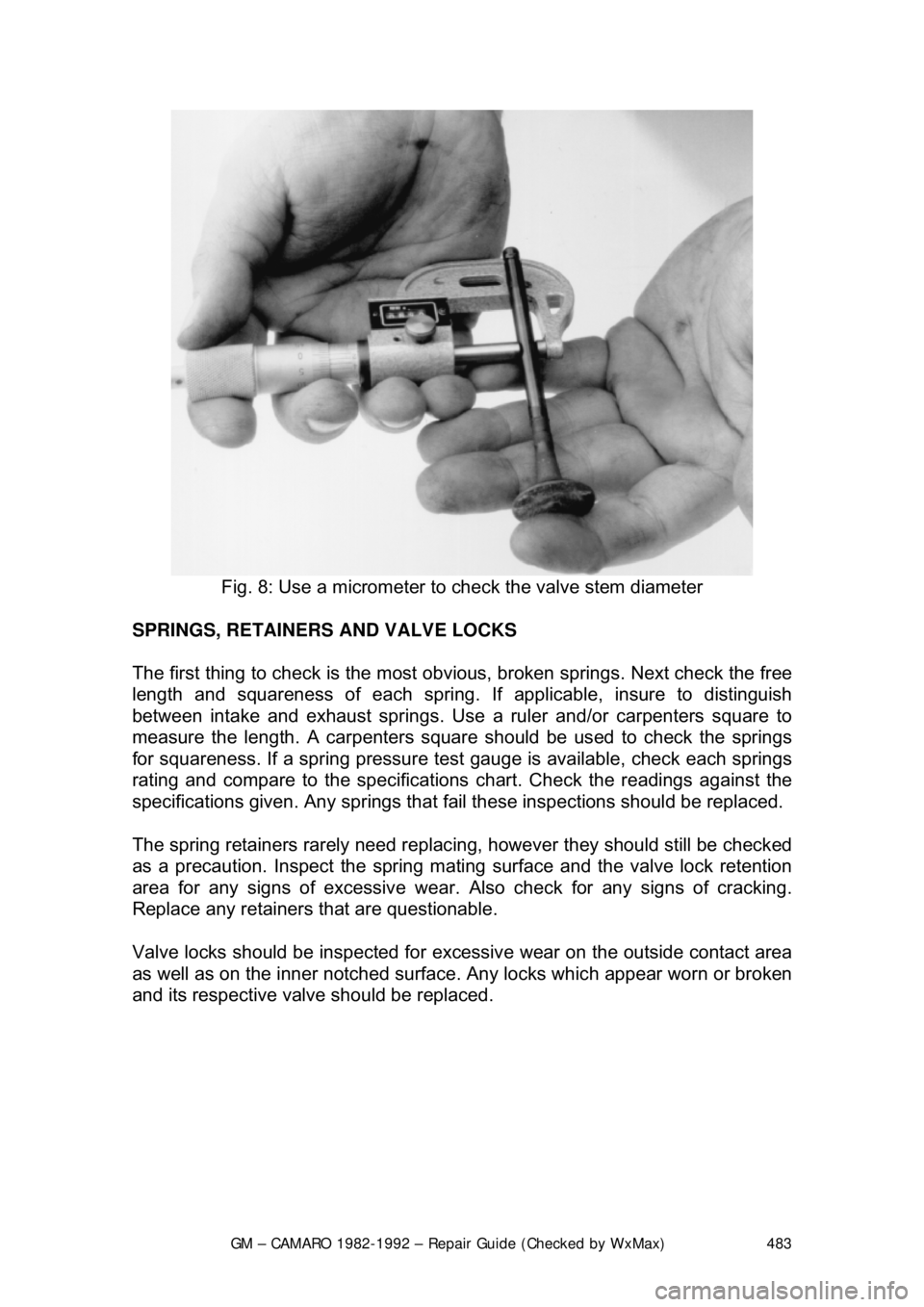
GM – CAMARO 1982-1992 – Repair Guide (Checked by WxMax) 483
Fig. 8: Use a micrometer to check the valve stem diameter
SPRINGS, RETAINERS AND VALVE LOCKS
The first thing to check is the most obv ious, broken springs. Next check the free
length and squareness of each spring. If applicable, insure to distinguish
between intake and exhaust springs. Use a ruler and/or carpenters square to
measure the length. A car penters square should be used to check the springs
for squareness. If a spring pressure test gauge is available, check each springs
rating and compare to the specifications chart. Check the readings against the
specifications given. Any springs that fa il these inspections should be replaced.
The spring retainers rarely need replacing, however they should still be checked
as a precaution. Inspect the spring mating surface and the valve lock re\
tention
area for any signs of excessive wear. Also check for any signs of cracking.
Replace any retainers t hat are questionable.
Valve locks should be inspected for exce ssive wear on the outside contact area
as well as on the inner notched surface. Any locks which appear worn or broken
and its respective valve should be replaced.
Page 484 of 875
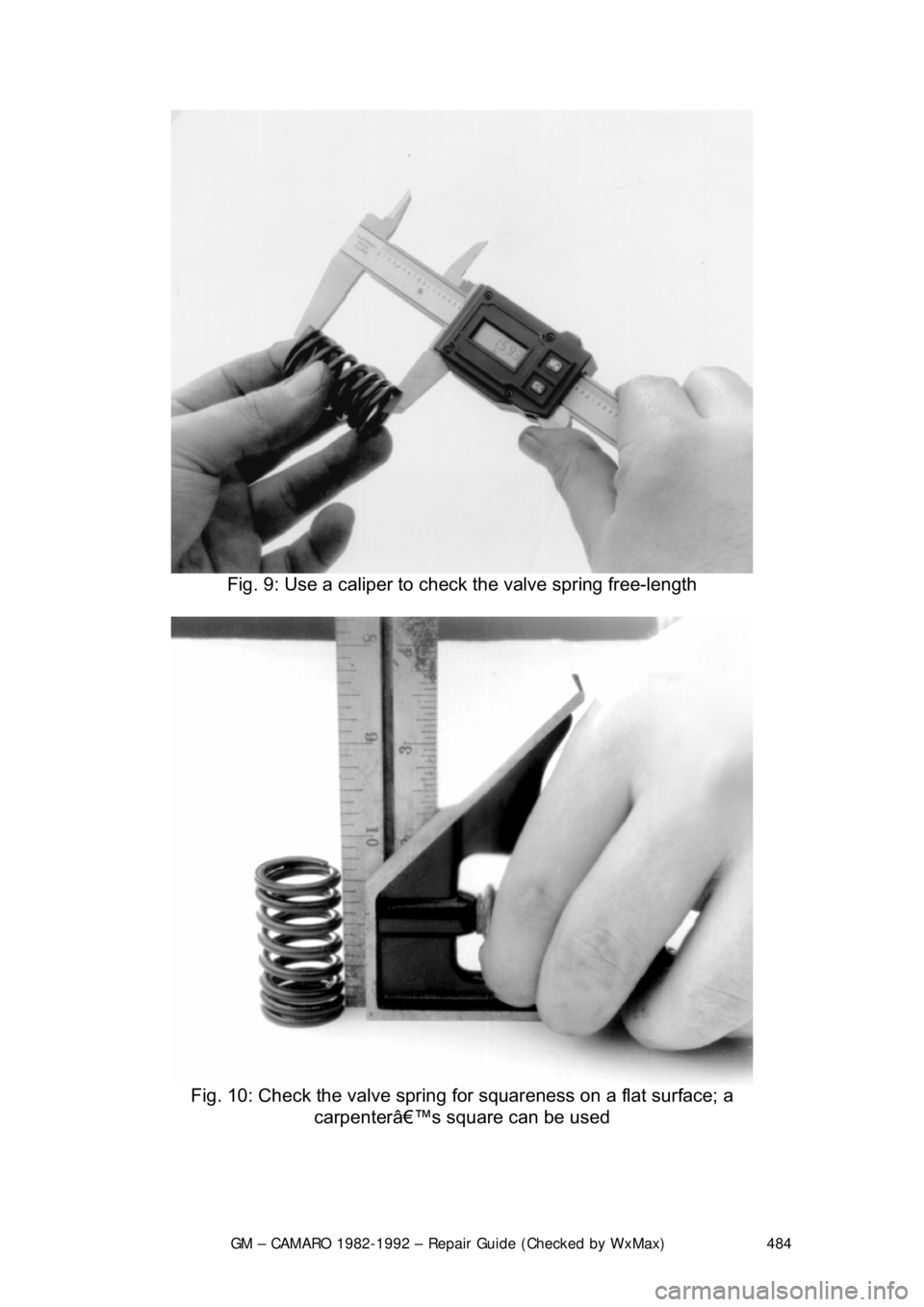
GM – CAMARO 1982-1992 – Repair Guide (Checked by WxMax) 484
Fig. 9: Use a caliper to che ck the valve spring free-length
Fig. 10: Check the valve spring for squareness on a flat surface; a
carpenter’s square can be used
Page 485 of 875
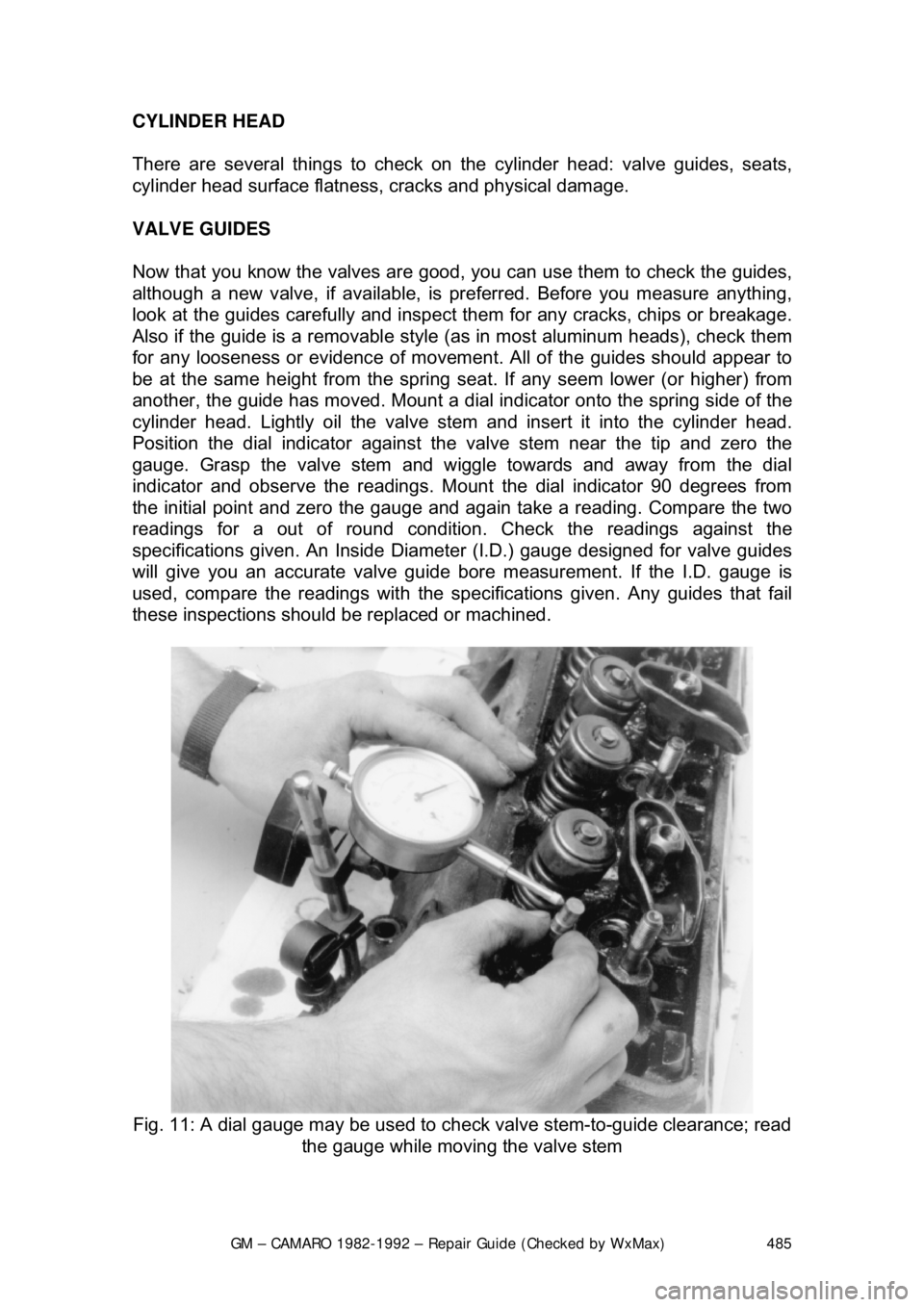
GM – CAMARO 1982-1992 – Repair Guide (Checked by WxMax) 485
CYLINDER HEAD
There are several things to check on
the cylinder head: valve guides, seats,
cylinder head surface flatness, cracks and physical damage.
VALVE GUIDES
Now that you know the valves are good, you can use them to check the guides,
although a new valve, if available, is preferred. Before you measure anything,
look at the guides carefully and inspect t hem for any cracks, chips or breakage.
Also if the guide is a removable style (a s in most aluminum heads), check them
for any looseness or evidence of movem ent. All of the guides should appear to
be at the same height from the spring s eat. If any seem lower (or higher) from
another, the guide has moved. Mount a dial indicator onto the spring side of the
cylinder head. Lightly oil the valve stem and insert it into the cylinder head.
Position the dial indicator against the valve stem near the tip and zero the
gauge. Grasp the valve stem and wiggle towards and away from the dial
indicator and observe the readings. Mount the dial indicator 90 degrees from
the initial point and zero the gauge and again take a reading. Compare the two
readings for a out of round condition. Check the readings against the
specifications given. An Inside Diamete r (I.D.) gauge designed for valve guides
will give you an accurate valve guide bore measurement. If the I.D. gauge is
used, compare the readings wit h the specifications given. Any guides that fail
these inspections should be replaced or machined.
Fig. 11: A dial gauge may be used to che ck valve stem-to-guide clearance; read
the gauge while moving the valve stem
Page 486 of 875
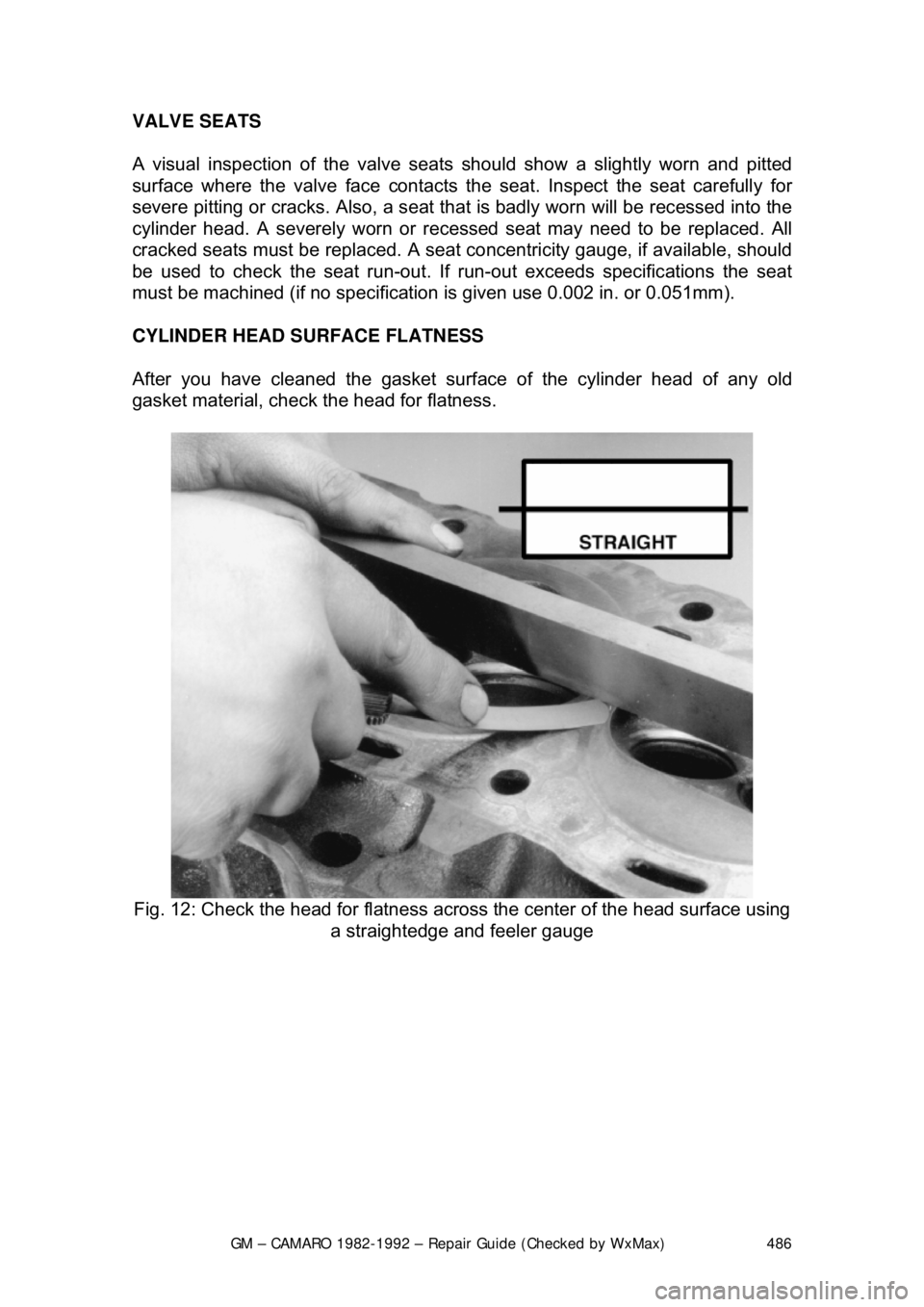
GM – CAMARO 1982-1992 – Repair Guide (Checked by WxMax) 486
VALVE SEATS
A visual inspection of the valve seats
should show a slightly worn and pitted
surface where the valve face contacts t he seat. Inspect the seat carefully for
severe pitting or cracks. Also, a seat t hat is badly worn will be recessed into the
cylinder head. A severely worn or rece ssed seat may need to be replaced. All
cracked seats must be replaced. A seat co ncentricity gauge, if available, should
be used to check the seat run-out. If run-out exceeds specifications the seat
must be machined (if no specification is given use 0.002 in. or 0.051mm).
CYLINDER HEAD SURFACE FLATNESS
After you have cleaned the gasket surf ace of the cylinder head of any old
gasket material, check the head for flatness.
Fig. 12: Check the head for flatness across the center of the head surface using
a straightedge and feeler gauge
Page 487 of 875
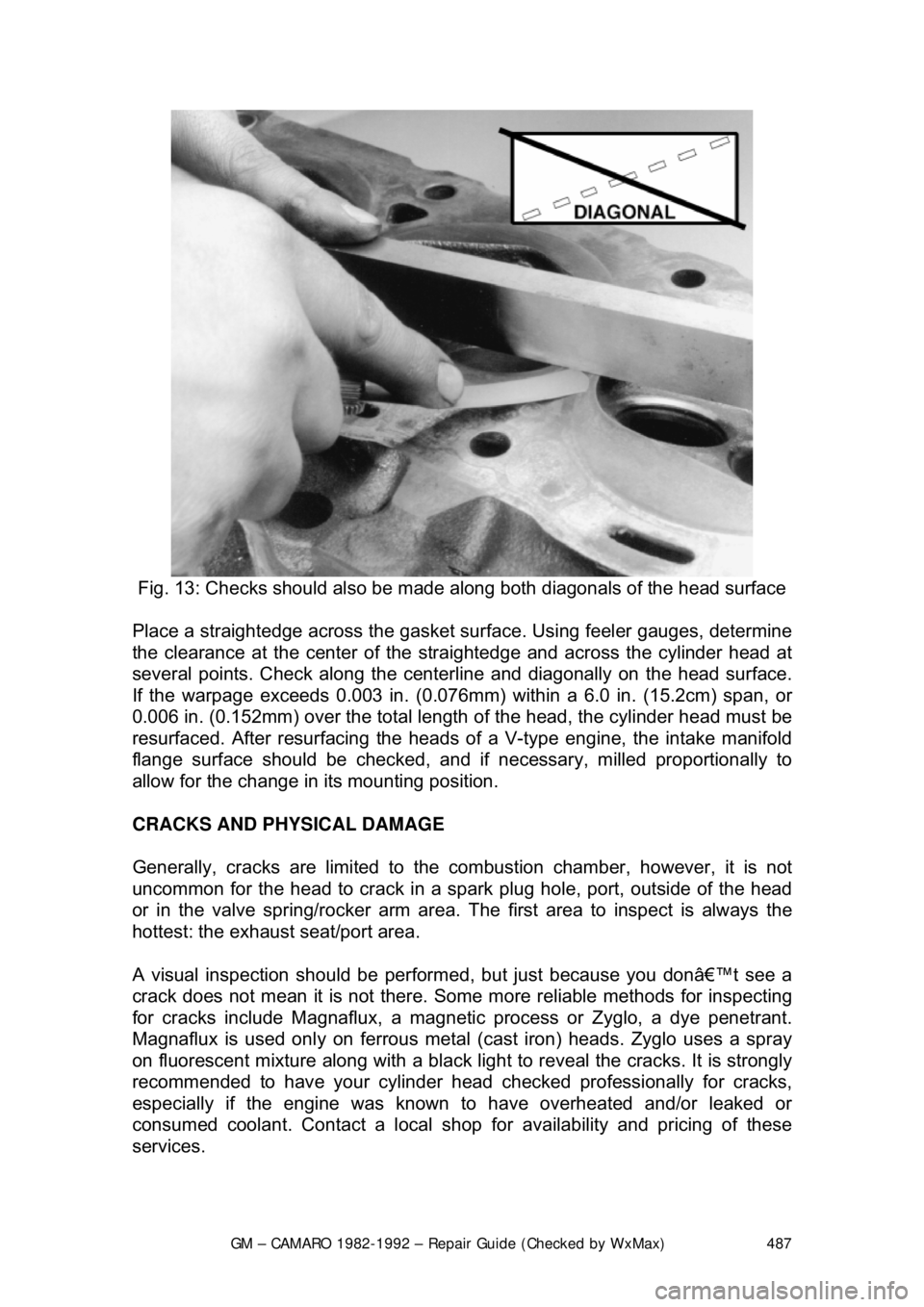
GM – CAMARO 1982-1992 – Repair Guide (Checked by WxMax) 487
Fig. 13: Checks should also be made al ong both diagonals of the head surface
Place a straightedge across the gasket surf ace. Using feeler gauges, determine
the clearance at the cent er of the straightedge and across the cylinder head at
several points. Check along the centerli ne and diagonally on the head surface.
If the warpage exceeds 0.003 in. (0.076mm) within a 6.0 in. (15.2cm) span, or
0.006 in. (0.152mm) over the total length of the head, the cylinder head must be
resurfaced. After resurfacing the heads of a V-type engine, the intake manifold
flange surface should be checked, and if necessary, milled proportionally to
allow for the change in its mounting position.
CRACKS AND PHYSICAL DAMAGE
Generally, cracks are limited to the comb ustion chamber, however, it is not
uncommon for the head to crack in a s park plug hole, port, outside of the head
or in the valve spring/rocker arm area. The first area to inspect is always the
hottest: the exhaust seat/port area.
A visual inspection should be perform ed, but just because you don’t see a
crack does not mean it is not there. Some more reliable methods for inspecting
for cracks include Magnaflux, a magnetic process or Zyglo, a dye penetrant.
Magnaflux is used onl y on ferrous metal (cast iron) heads. Zyglo uses a spray
on fluorescent mixture along with a black light to reveal the cracks. It is strongly
recommended to have your cylinder head c hecked professionally for cracks,
especially if the engine was known to have overheated and/or leaked or
consumed coolant. Contact a local shop fo r availability and pricing of these
services.
Page 488 of 875

GM – CAMARO 1982-1992 – Repair Guide (Checked by WxMax) 488
Physical damage is usually very eviden
t. For example, a broken mounting ear
from dropping the head or a bent or broken stud and/or bol t. All of these defects
should be fixed or, if irrepairabl e, the head should be replaced.
REFINISHING & REPAIRING
Many of the procedures given for refini shing and repairing the cylinder head
components must be performed by a ma chine shop. Certain steps, if the
inspected part is not worn, can be perfo rmed yourself inexpensively. However,
you spent a lot of time and effort so far, why risk trying to save a couple bucks if
you might have to do it all over again?
VALVES
Any valves that were not replaced s hould be refaced and the tips ground flat.
Unless you have access to a valve grinding machine, this should be done by a
machine shop. If the valves are in extr emely good condition, as well as the
valve seats and guides, they may be lapped in without performing machine
work.
It is a recommended practice to lap the valves even after machine work has
been performed and/or new valves hav e been purchased. This insures a
positive seal between the valve and seat.
LAPPING THE VALVES
Before lapping the valves to the seat s, read the rest of the cylinder head
information to insure that any related parts are in acceptable enough condition
to continue.
Before any valve seat machining and/or lapping can be performed, the guides
must be within factory re commended specifications.
1. Invert the cylinder head.
2. Lightly lubricate the va lve stems and insert them into the cylinder head in
their numbered order.
3. Raise the valve from the seat and apply a sma ll amount of fine lapping
compound to the seat.
4. Moisten the suction h ead of a hand-lapping tool and attach it to the head
of the valve.
5. Rotate the tool bet ween the palms of both hands , changing the position
of the valve on the valve seat and lifting the tool often to prevent
grooving.
6. Lap the valve until a smooth, polished circle is evident on the valve and
seat.
7. Remove the tool and the valve. Wi pe away all traces of the grinding
compound and store the valve to maintain its lapped location.
SPRINGS, RETAINERS AND VALVE LOCKS
Page 489 of 875

GM – CAMARO 1982-1992 – Repair Guide (Checked by WxMax) 489
There is no repair or refinishing possi
ble with the springs, retainers and valve
locks. If they are found to be worn or defective, they must be replaced with new
(or known good) parts.
CYLINDER HEAD
Most refinishing procedures dealing wit h the cylinder head must be performed
by a machine shop. Read the informati on below and review your inspection
data to determine whether or not machining is necessary.
VALVE GUIDE
If any machining or replacements are made to the valve guides, the seats must
be machined.
Unless the valve guides need machining or replacing, the only service to\
perform is to thoroughly clean them of any dirt or oil residue.
There are only two types of valve gu ides used on automobile engines: the
replaceable-type (all alumi num heads) and the cast-in in tegral-type (most cast
iron heads). There are four recommended methods for repairing worn guides.
• Knurling
• Inserts
• Reaming oversize
• Replacing
Knurling is a process in which metal is displaced and raised, thereby reducing
clearance, giving a true center, and providing oil control. It is the least
expensive way of repairing the valve guides . However, it is not necessarily the
best, and in some cases, a knurled valve guide will not stand up for more than a
short time. It requires a special knurle r and precision reaming tools to obtain
proper clearances. It would not be cost effective to purchase these tools, unless
you plan on rebuilding several of the same cylinder head.
Installing a guide insert involves machin ing the guide to accept a bronze insert.
One style is the coil-type wh ich is installed into a threaded guide. Another is the
thin-walled insert where the guide is ream ed oversize to accept a split-sleeve
insert. After the insert is installed, a s pecial tool is then run through the guide to
expand the insert, locking it to the guide. The insert is then reamed to the
standard size for proper valve clearance.
Reaming for oversize valves restores normal clearances and provides a true
valve seat. Most cast-in type guides can be reamed to accept an valve wi\
th an
oversize stem. The cost factor for this can become quite high as you will need
to purchase the reamer and new, oversize stem valves for all guides which
were reamed. Oversizes ar e generally 0.003 to 0.030 in. (0.076 to 0.762mm),
with 0.015 in. (0.381mm) being the most common.
Page 490 of 875

GM – CAMARO 1982-1992 – Repair Guide (Checked by WxMax) 490
To replace cast-in type valve guides, t
hey must be drilled out, then reamed to
accept replacement guides. This must be done on a fixture which will allow
centering and leveling off of the original valve seat or guide, otherwise a serious
guide-to-seat misalignment may occur maki ng it impossible to properly machine
the seat.
Replaceable-type guides are pressed into the cylinder head. A hammer and a
stepped drift or punch may be used to inst all and remove the guides. Before
removing the guides, measure the protrusi on on the spring side of the head and
record it for installation. Use the stepped drift to hammer out the old guide from
the combustion chamber side of the head. When installing, determine whether
or not the guide also seal s a water jacket in the head, and if it does, use the
recommended sealing agent. If there is no water jacket, grease the valve guide
and its bore. Use the stepped drift, and hamme r the new guide into the cylinder
head from the spring side of the cylinder head. A stack of washers the same
thickness as the measured protrusion may help the installation process.
VALVE SEATS
Before any valve seat machining can be performed, the guides must be within
factory recommended specifications.
If any machining or replacements were made to the valve guides, the seats
must be machined.
If the seats are in good condition, the va lves can be lapped to the seats, and the
cylinder head assembled. See the valves in formation for instructions on lapping.
If the valve seats are worn, cracked or damaged, they must be serviced by a
machine shop. The valve seat must be per fectly centered to the valve guide,
which requires very accurate machining.
CYLINDER HEAD SURFACE
If the cylinder head is war ped, it must be machined flat. If the warpage is
extremely severe, the head may need to be replaced. In some instances, it may
be possible to straighten a warped head enough to allow machining. In either
case, contact a professional machine shop for service.
CRACKS AND PHYSICAL DAMAGE
Certain cracks can be repaired in both ca st iron and aluminum heads. For cast
iron, a tapered threaded insert is inst alled along the length of the crack.
Aluminum can also use the tapered inse rts, however welding is the preferred
method. Some physical damage can be repaired through brazing or welding.
Contact a machine shop to get expert advice for your particular dilemma.
ASSEMBLY